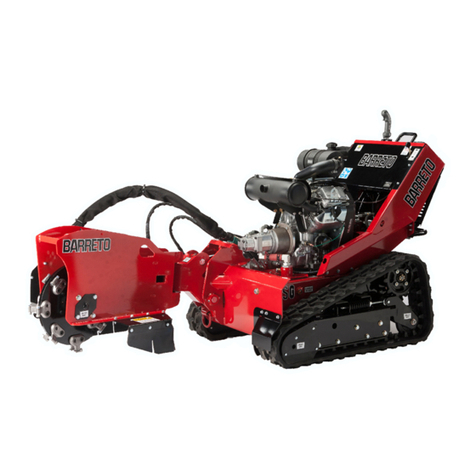Barreto 712MT User manual

712MT OPERATOR’S MANUAL 11/19/12 Page 1 of 16
THE
MODEL 712MT
HYDRAULIC MICRO TRENCHER
OPERATOR’S MANUAL
TRENCHER INTENDED USE
This machine is designed for digging trenches in “normal” ground of reasonably soft dirt and stones up to 3” (7.62cm)
in diameter. Ground with larger stones, high clay content, very hard packed, very dry, or in a frozen condition may be
unsuitable for normal trenching. Consider using a backhoe or other heavier equipment for such conditions.
TABLE OF CONTENTS
LUBRICATION REQUIREMENTS 2
SAFETY MESSAGES 3
SAFETY INSTRUCTIONS OVERVIEW 3
TRENCHER OPERATING INSTRUCTIONS 6
CONTROLS 6
ENGINE CONTROLS 7
ENGINES 8
ENGINE START UP PROCEDURE 8
GETTING STARTED 9
TRENCHING PROCEDURE 9
TRENCHING TIPS 9
SHUT DOWN PROCEDURE 10
GROUND TRANSPORT OF THE TRENCHER 10
ROAD TRANSPORT OF THE TRENCHER 11
OPERATOR PREPARATION 11
DETERMINE LOCATION OF UNDERGROUND UTILITIES 13
CONTACT WITH UNDERGROUND UTILITIES 14
WORK SITE ASSESSMENT 15
INDEX 16

712MT OPERATOR’S MANUAL 11/19/12 Page 2 of 16
LUBRICATION REQUIREMENTS
Grease at the intervals indicated per the illustration of grease lubrication points. There is also a grease diagram decal on
the machine.

712MT OPERATOR’S MANUAL 11/19/12 Page 3 of 16
SAFETY MESSAGES
General safety messages are listed in this Safety Messages section. Specific safety messages appear as appropriate in
this manual where a potential hazard may occur if procedures or instructions are not followed correctly and completely.
SAFETY SYMBOL
This is the international safety alert symbol. This symbol is used in combination with a signal word and written
message to warn you of a potential for bodily injury or death.
A signal word "DANGER", "WARNING", or "CAUTION" is used with the safety alert symbol.
DANGER: Imminent hazards that, if not avoided, will result in serious personal injury or death.
WARNING: Potential hazards or unsafe practices that, if not avoided, could result in serious personal injury or
death.
CAUTION: Potential hazards or unsafe practices that, if not avoided, could result in minor personal injury,
product damage, or property damage.
Safety decals with a signal word "DANGER", "WARNING", or "CAUTION" are affixed to the trencher near specific
hazards.
Read this manual and study ALL decals on the trencher before operating the trencher.
SAFETY INSTRUCTIONS OVERVIEW
READ SAFETY AND OPERATING INSTRUCTIONS BEFORE OPERATING!
USE COMMON SENSE AND PLENTY OF IT!
The left lever is the trench chain control. The right lever is the wheel drive engage control. All motion stops when the
levers are released.
DO NOT TAPE THE LEVERS UP or by-pass this safety feature in any other way.
Call before you dig. If you do not call, you may cause an accident, suffer injuries or death, cause interruption of
services, damage the environment, and/or incur project delays. Expect to be held liable for any damages caused if you
fail to call.
DANGER: Buried electric cables or gas lines can cause serious injury or death if struck with dig chain. Always
determine location of utilities before trenching.
WARNING: Fiber optic cables convey laser light that can injure your eyesight.
STAY CLEAR of moving parts on the trencher.
DANGER: Digging chain, auger and other moving parts can cut off arms, legs, or
fingers. Contact with the digging chain or auger while in operation will cause
serious injury or even death.

712MT OPERATOR’S MANUAL 11/19/12 Page 4 of 16
SAFETY INSTRUCTIONS OVERVIEW (continued)
Wear safety goggles and a hard hat while operating or observing!
WARNING: The dig chain may throw stones and debris.
Wear adequate hearing protection while operating or observing.
WARNING: Exposure to loud noise is cumulative and may permanently
damage your hearing.
Wear safety boots and gloves. Wear close-fitting clothing. Contain
long hair. Do not wear jewelry. Wear reflective clothing if working near traffic.
Only operate outdoors and avoid breathing engine exhaust and fumes.
WARNING: Engine exhaust contains carbon monoxide gas that is toxic.
Breathing it can cause unconsciousness and death.
Adequate lighting is required, daylight or artificial, for safe operation of the trencher.
Allow adequate side and overhead clearances between trencher and buildings, fences, and trees.
WARNING: If the digging chain contacts an object, the digging chain can climb upward quickly and tip the
trencher toward the operator. Serious injury or death will result by operator contact with the moving chain. The
digging chain can suddenly drag the machine forward if the trencher is forced too quickly into the ground or
catches on a buried object.
WARNING: Contact with the dig chain or auger while in operation will cause serious injury or even death. The
teeth of the dig chain are sharp. Avoid contact even when the chain is not moving.
Avoid inclines if at all possible.
WARNING: Navigating on any incline increases the danger of the trencher losing traction or rolling over,
especially if the surface is wet. If you lose control, get out of the way immediately to avoid personal injury.
Navigation on inclines should be especially slow and turns very gradual. Refer to the incline diagram in the
section, “GROUND TRANSPORT”.
WARNING: The weight of the trencher or walking near the edge of the trench could cause collapse of the
trench wall. If driven along the edge of the trench, the trencher could suddenly turn over.
Avoid operating adjacent to drop-offs or embankments.
WARNING: The trencher is very heavy. DO NOT attempt to manually lift it.
Keep away from wheels to avoid getting crushed.
WARNING: Getting run over by the trencher will cause injury.
Always leave trencher parked on a level surface.
WARNING: Do not park on incline. Move the trencher to a level area.
Do not leave trencher unattended with the engine running.

712MT OPERATOR’S MANUAL 11/19/12 Page 5 of 16
SAFETY INSTRUCTIONS OVERVIEW (continued)
Do not operate trencher near any source of flammable dust or vapors.
WARNING: Sparks from the engine exhaust can cause an explosion or fire in a flammable or explosive
atmosphere. Fuel fumes can catch fire or explode.
Do not operate trencher near flames or sparks.
WARNING: Fuel fumes can catch fire or explode.
Shut off engine and allow it to cool before refueling.
WARNING: Fuel fumes can catch fire or explode. Do not smoke when refueling. Do not refuel near a source
of flames or sparks.
Do not touch the engine, muffler, or any of the hydraulic components until cool.
WARNING: Muffler and engine get hot enough to cause serious burns. For the safety of yourself and others,
allow enough time for the engine, muffler, and the hydraulic fluid to cool completely before performing any
cleaning or maintenance.
Avoid contact with hydraulic fluid.
WARNING: When machine is operating, hydraulic fluid is under extreme pressure and can get under skin and
burn or poison.
Keep others away. If the job site is near a road or pedestrian path, warn and divert both motorized traffic and
pedestrians. As appropriate, use traffic flag personnel, signs, cones, and lighting devices to insure safety.
WARNING: Someone could step into the trench by accident. Walking near the edge of the trench could cause
collapse of the trench wall and possibly cause someone to fall onto the moving chain. Contact with the digging
chain or auger while in operation will cause serious injury or even death.
Never allow anybody to ride on the trencher.
Never lift trencher over any person at any time.
WARNING: If trencher should fall it would crush anybody under it.
We recommend having a fire extinguisher suitable for petrol fires in the operating area.
Attachments can change the center of mass and machine operations. Use only Barreto attachments.

712MT OPERATOR’S MANUAL 11/19/12 Page 6 of 16
TRENCHER OPERATING INSTRUCTIONS
READ SAFETY INSTRUCTIONS BEFORE OPERATING! Both the SAFETY INSTRUCTIONS and OPERATING
INSTRUCTIONS are in this manual.
Be sure that the engine oil and fuel and the machine hydraulic fluid are all at proper levels before starting the engine.
STUDY AND UNDERSTAND CONTROLS BEFORE BEGINNING OPERATION.
CONTROLS
1. FREEWHEELING HUBS: To unlock: Line up roll pin in locking pin to the slot in the locking plate. To help line up
the roll pin under the lock plate with the slot, the finger pull ring and the roll pin are aligned with each other on the lock
pin. Pull out on spring loaded lock pin until the roll pin clears the slot, and then turn 90 degrees. To engage either hub,
turn the lock pin handle in to allow the spring loaded pin to engage. Repeat for the other wheel. Push the trencher a bit
if necessary until each pin finds a hole to drop into. The hubs are now locked. Disengaging one hub makes it much
easier to turn the trencher when transporting under power.
2. IGNITION SWITCH: There are two switches. One is the switch that comes on the engine. The other is located on
the control panel. Either switch will stop the engine. BOTH must be in the ON position to start. Refer to the ENGINE
START UP PROCEDURE.
3. WHEEL DRIVE CONTROL: The Wheel drive lever must be in ON position when engaging the control lever.
•Pushing Direction control lever to the forward position will cause machine to move forward.
•Pulling Direction control lever back will cause machine to move backward.
•Very slow speed is required for trenching in most conditions.
NOTE: Be sure operator understands that the machine moves BACK when trenching, not forward.
4. TRENCH CHAIN CONTROL: To trench, hold lever in TRENCH position. To remove debris from chain push lever
down to reverse chain.
5. DIGGING BOOM CONTROL: Pull back to raise the digging boom and push forward to lower the boom.

712MT OPERATOR’S MANUAL 11/19/12 Page 7 of 16
TRENCH CHAIN CONTROL IGNITION WHEEL DRIVE DIRECTION CONTROL
WHEEL DRIVE ENGAGE LEVER DIGGING BOOM CONTROL
ENGINE CONTROLS
CHOKE: Use to aid starting the engine when it is cold.
IGNITION SWITCH: There are two ignition switches. One switch is located on the control panel with the other
trencher controls for your convenience. The other is located on the engine. Use these to start and stop the engine. Refer
to the ENGINE START UP PROCEDURE.
THROTTLE: Use this to adjust engine speed. Refer to the ENGINE START UP PROCEDURE
GAS SHUT-OFF: Use this when starting or stopping machine. Refer to the ENGINE START UP AND SHUT DOWN
PROCEDURE.

712MT OPERATOR’S MANUAL 11/19/12 Page 8 of 16
GAS SHUTOFF THROTTLE
CHOKE IGNITION
GAS SHUT-OFF THROTTLE
ENGINE START UP PROCEDURE
Only operate trencher outdoors and avoid breathing engine exhaust and fumes.
WARNING: Engine exhaust contains carbon monoxide gas that is toxic. Breathing it can cause
unconsciousness and death. Avoid any areas or actions that expose you to carbon monoxide.
1. Turn both IGNITION switches on. The switch located with the other trencher controls and the switch located on
the engine.
2. Release the WHEEL DRIVE ENGAGE CONTROL.

712MT OPERATOR’S MANUAL 11/19/12 Page 9 of 16
ENGINE START UP PROCEDURE (continued)
3. Open the FUEL SHUTOFF VALVE located below the choke on the engine.
4. If the engine is cold, close the CHOKE. After engine starts, move the choke to half open. After about 30 seconds to
a minute the choke can be opened completely. To restart a warm engine, leave the choke in the open position.
5. Move the THROTTLE to about 1/3 of the way back. This increases throttle. It is located above choke.
6. Pull start cord located on engine recoil.
When the engine starts, open the CHOKE (turn choke off) after the engine warms up enough.
COLD WEATHER OPERATIONS: Before operating in cold weather, refer to the Engine Owner’s Manual for
recommended engine oil. Do not spray starting fluid into the air cleaner as engine damage could result. If the machine
is operated at temperatures below +32°F (0°C) then changing the hydraulic fluid to ISO 46 is recommended. If you do
not want to change the hydraulic fluid but want to operate the machine at temperatures below +32°F (0°C), then do the
following:
•Warm up engine at a low speed.
•Gradually increase engine speed to half throttle, allowing 30 minutes for the hydraulic fluid to warm up.
Reduce the engine speed if the hydraulic pump whines. Pump noise may indicate a lack of hydraulic fluid flow that
could damage the pump. For frequent starts below 18°F consult your dealer or the factory.
GETTING STARTED
1. Lock wheel hubs
2. Start and warm up engine.
3. Put the WHEEL DIRECTION CONTROL in desired position and pull the WHEEL DRIVE ENGAGE LEVER.
4. Adjust the travel speed and navigate the trencher to the starting position. The trencher is designed to dig toward the
operator (with the Wheel Drive Control in reverse). With this in mind, position the machine to start the trench.
TRENCHING PROCEDURE
1. Have engine at full throttle.
2. Put the WHEEL DRIVE CONTROL in reverse position.
3. Push the BOOM CONTROL outward (right) to disengage the position lock and move the control forward one
notch. As the chain touches the ground, tilt the machine back until BOOM CONTROL snaps into the first position.
4. Pull the TRENCH CHAIN CONTROL to “ON” position to activate dig chain. The chain will dig into the ground
and the trencher will set level. If a deeper depth is required, continue the same process until desired depth. Then
pull the WHEEL DRIVE ENGAGE LEVER to progress backward.
Note: The dig chain will not operate if the WHEEL DRIVE CONTROL is in the forward position. The machine
trenches backward, toward the operator. The WHEEL DRIVE CONTROL must be in reverse position.
TRENCHING TIPS
THE PLUNGE CUT:
If the boom bounces when lowering it, use a more gradual “boom down” action. A little ground travel toward the
operator during the plunge cut may help reduce bounce.
Do not overload engine. If the engine lugs down or the digging chain slows down, release the WHEEL DRIVE
CONTROL until the engine recovers to operating speed, then reactivate the WHEEL DRIVE CONTROL.
If traction is limited, the trencher may be tilted back as when initially starting the trench. When it is tilted back, the
wheels will pull the trencher toward the operator a few inches. Release the pressure on the handlebars and allow the
trencher weight to plunge cut into the ground. When trencher is level again, repeat the process. This series of plunge
cuts is known as the can opener approach and can be productive when the wheels do not have the traction to drive.
Do not attempt to force boom down faster than digging chain can remove material.

712MT OPERATOR’S MANUAL 11/19/12 Page 10 of 16
SHUT DOWN PROCEDURE
1. Always leave trencher parked on a level surface.
WARNING: Do not park on incline.
Move the trencher to a level surface.
2. Unless loaded on a trailer, lower the boom to the ground.
3. Reduce the ENGINE THROTTLE to idle.
4. Move the IGNITION SWITCH to the OFF position to stop the engine.
5. Close the FUEL SHUTOFF VALVE.
Shut off engine and allow it to cool before refueling.
WARNING: Fuel fumes can catch fire or explode. Do not smoke or allow flames or sparks in the area.
Do not touch the engine, muffler, or any of the hydraulic components until cool.
WARNING: Muffler and engine get hot enough to cause serious burns. For the safety of yourself and others,
allow enough time for the engine, muffler, and the hydraulic fluid to cool completely before performing any
cleaning or maintenance.
GROUND TRANSPORT OF THE TRENCHER
Raise the digging chain boom.
WARNING: Contact with the dig chain or auger while in operation will cause serious injury or even death.
The teeth of the dig chain are sharp. Avoid contact even when the chain is not moving.
Use the WHEEL DRIVE CONTROL to control travel direction. The WHEEL DRIVE ENGAGE LEVER must be
pulled and held to move trencher.
•Pushing the Wheel Drive Control forward causes the machine to move forward.
•Pulling the Wheel Drive Control back causes the machine to move backward.
•If you are not experienced operating this trencher, a slow ground speed is recommended for your safety. Use half
throttle for slower transport speed.
Keep away from tires to avoid getting crushed.
WARNING: Getting run over by the trencher will cause injury.
Never allow anybody to ride on the trencher.
Never make sudden changes in speed or direction.
Use extra caution on soft or uneven ground.
Avoid operating adjacent to drop-offs or embankments.
Avoid inclines if at all possible. Never use on any incline exceeding the angles shown below.
WARNING: Navigating on any incline increases the danger of the trencher losing traction or rolling over,
especially if the surface is wet. If you lose control get out of the way immediately to avoid personal injury.
Navigation on inclines should be especially slow and turns very gradual.
A 20° maximum incline is allowed. Honda engines have an Oil Alert system that will automatically stop the engine if
tipped more than 20°.

712MT OPERATOR’S MANUAL 11/19/12 Page 11 of 16
ROAD TRANSPORT OF THE TRENCHER
The BEST way to transport the trencher over roads is with the BARRETO E3X4DGT TRAILER.
Refer to the following checklist before towing:
•Towing vehicle should have a 2" (5cm) ball. Be sure it is in good repair and securely fastened to the vehicle.
•Securely fasten the hitch to the ball by tightening the hitch nut.
•Thread the safety chain through the loop in the hitch nut handle to prevent it from vibrating loose while towing.
•Attach the safety chain to the towing vehicle in such a way that it cannot come off accidentally.
•Check the hitch-to-ball connection after driving a few blocks and re-tighten if necessary.
Always exercise extreme caution and allow extra clearance while towing a trailer.
DRIVE SAFELY!
LOADING PROCEDURE: 712 trencher onto the Barreto E3X4DGT trailer:
1. Position the tow vehicle and attached trailer on level ground.
2. Unlatch the ramps and lower to the ground
3. Line up the trencher with the rear of the trailer. The dig chain should be toward the trailer.
4. Throttle engine down and move control speed lever halfway between reverse and forward. The
speed lever will allow variable speed in forward. Pull the wheel drive engagement lever and slowly drive the trencher
forward onto the trailer bed.
WARNING: Navigating on the inclined trailer bed or ramps increases the danger of the trencher tires losing
traction, especially if the bed surface is wet. Stay out of the way to avoid personal injury if you lose control.
5. Drive front trencher wheel into wheel pocket in the front of trailer.
6. Shut off engine and close the fuel shutoff valve. Refer to the SHUT DOWN
PROCEDURE for details.
7. Secure trencher to front wheel pocket with the spring loaded pin. Lock rear of
trencher down with safety tie down chains.
8. Raise and lock ramps.
UNLOADING PROCEDURE: 712 from the Barreto E3X4DGT trailer:
1. Position the tow vehicle and attached trailer on level ground.
2. Lower ramps to the ground.
3. Remove all chains or straps connecting the trencher to the trailer D-rings.
4. Remove front wheel lock pin holding trencher into wheel pocket.
5. Start the engine using the ENGINE START UP PROCEDURE.
6. Move wheel direction control to reverse and engage wheel drive lever.
Carefully drive the trencher slowly backward and down the ramps.
OPERATOR PREPARATION
Each operator must:
•Become familiar with the controls and operation of the trencher, preferably under the supervision of an experienced
operator.
•Be 18 yrs. of age or older and be mentally and physically capable of operating the trencher safely.
•Have studied the SAFETY AND OPERATING INSTRUCTIONS in this manual.
PERSONAL PROTECTION: For safety, trencher operator should wear personal protection equipment. Keep observers
at a safe distance.

712MT OPERATOR’S MANUAL 11/19/12 Page 12 of 16
OPERATOR PREPARATION (continued)
Wear safety eye goggles and a hard hat while operating or observing!
WARNING: The dig chain may throw stones and debris.
Wear safety boots and gloves. Wear close-fitting clothing. Contain long
hair. Do not wear jewelry. Wear reflective clothing if working near
traffic.
Wear adequate hearing (ear) protection while operating or observing.
WARNING: Exposure to loud noise is cumulative and may
permanently damage your hearing.
Declared vibration emission value in accordance with EN 12096: the
average measured vibration emission value is 5.5 m/s2. The uncertainty
in the measurement given a 95% confidence interval is 1.1 m/s2. Safety
gloves help to isolate the hands from the vibration, keep them warm and
dry, maintain blood circulation, and make operators less susceptible to vibration induced injury.
Hearing protection devices do not all provide the same level of protection. Those that completely surround each ear are
better than earplugs. It is important to select a device that is adequate and appropriate for your specific work
environment since the peak noise level varies. A local environmental noise specialist may help you to determine the
level of hearing protection required.
DECLARED DUAL-NUMBER NOISE EMISSION VALUES
in accordance with ISO 4871
Measured A-weighted sound power level,
LWA (ref. 1pW) in decibels
Uncertainty, KWA, in decibels
Measured A-weighted sound pressure level, L
pA
(ref. 20µPa) at the operator's position in decibels
Uncertaint K Ain decibels
Operating Mode 1
92.1
3.0
88.6
30
Values determined according to noise test code given in Directive 2000/14/EC Annex
IIIB part 54 using the basic standard ISO 3744: 1994
NOTE - The sum of a measured noise emission value and its associated uncertainty represents an
upper boundary of the range of values which is likely to occur in measurements.

712MT OPERATOR’S MANUAL 11/19/12 Page 13 of 16
DETERMINE LOCATION OF UNDERGROUND UTILITIES
OSHA CFR 29 1926.651 requires that the estimated location of underground utilities be determined before beginning
excavation or an underground drilling operation. When the actual excavation or bore approaches an estimated utility
location, the exact location of the underground installation must be determined by a safe, acceptable and dependable
method. If any utility cannot be precisely located, the appropriate utility company must shut it off.
Call before you dig. If you do not call, you may cause an accident; suffer injuries or death; cause interruption of
services; damage the environment; and/or incur project delays. Expect to be held liable for any damages caused, if you
fail to call.
DANGER: Buried electric cables or gas lines can cause serious injury or death if struck with dig chain. Always
determine location of utilities before trenching.
WARNING: Fiber optic cables convey laser light that can injure your eyesight.
CALL 811 or 1-888-258-0808 TO LOCATE UTILITIES BEFORE TRENCHING (US. OR CANADA).This free
service will provide a “One-Call” number for the geographic area that you select. Before you start any digging project,
be sure to call the local One-Call system in your area and any utility company that does not subscribe to the One-Call
system. The One-Call representative will notify participating utility companies of your proposed digging activities.
Utilities will then mark their underground facilities by using the following international marking codes:
Red Electric
Yellow Gas, oil, or petroleum
Orange Communication, telephone, television
Blue Potable water
Green/brown Sewer
White Proposed excavation
Pink Surveying
For areas not represented by One-Call Systems International, contact the appropriate utility companies to locate and
mark the underground installations. Do not rely on visual evidence of underground utilities such as manhole covers or
electrical drop boxes…CALL!

712MT OPERATOR’S MANUAL 11/19/12 Page 14 of 16
CONTACT WITH UNDERGROUND UTILITIES
After LOCATING UNDERGROUND UTILITIES and performing the WORK SITE ASSESSMENT, accidental dig
chain contact with a buried utility might still occur. If it does, stop digging and call 911 for help.
If you cut a wire or cable, assume that you do not know what kind it is. It may be electrical or any one of several
communication lines: telephone, television, or fiber optic. In any case, do not touch it or even look at the ends of it.
Stop digging and call 911 for help. Do not dig any more until the appropriate utility company has assessed the situation,
taken appropriate action, and informed you that is safe to proceed.
If you strike a pipe, it could be gas, oil, petroleum, water or sewer. In any case, stop digging, shut off the engine, and
evacuate the area immediately. Call 911 for help.
Electrical wires or cables: If you think that you may have severed electrical wires, stop digging and call 911 for help.
Keep yourself and other people away from the area.
DANGER: An electric shock could kill you. Assume that any severed wire or cable is HOT with voltage and
do not touch it!
Gas lines: If you think that you may have struck a gas line, shut off the engine and evacuate the area immediately. Call
911 for help.
DANGER: A gas explosion could kill you. Sparks will likely occur from the dig chain scraping the metal pipe.
If gas leaks out an explosion could easily occur.
Fiber optic cables: If you think that you may have severed a fiber optic cable, do not touch or even look at the ends of
it. WARNING: Fiber optic cables convey laser light that can injure your eyesight. Call 911 for help.

712MT OPERATOR’S MANUAL 11/19/12 Page 15 of 16
WORK SITE ASSESSMENT
Examine the work area for any conditions or obstructions that may inhibit trenching or create a safety hazard for the
operator or others. Use the information in this manual combined with good judgment to identify any hazards to avoid.
In addition to calling to DETERMINE LOCATION OF UNDERGROUND UTILITIES (see previous section for
details), the operator and/or job foreman should visually inspect the work site. Look for electrical drop boxes, notices of
underground placements, manhole covers, recent trenching activity, any evidence of possible underground placements,
banks, overhangs, drop-offs, rocks, tree limbs, wire, uneven terrain, any existing trenches or holes and toxic ground
conditions.
Only operate trencher outdoors and avoid breathing engine exhaust and fumes.
WARNING: Engine exhaust contains carbon monoxide gas that is toxic. Breathing it can cause
unconsciousness and death.
Do not operate trencher near any source of flammable dust or vapors.
WARNING: Sparks from the engine exhaust can cause an explosion or fire in a flammable or explosive
atmosphere. Fuel fumes can catch fire or explode.
Allow adequate side and overhead clearances between trencher and any objects such as buildings, fences, and trees.
WARNING: If the digging chain contacts an object, the digging chain can climb upward quickly and tip the
trencher toward the operator. Serious injury or death will result by operator contact with the moving chain or
auger. The digging chain can suddenly drag the machine forward if the trencher is forced too quickly into the
ground or catches on a buried object.
Adequate lighting is required, daylight or artificial, for safe operation of the trencher.
Keep others away. If the job site is near a road or pedestrian path, warn and divert both motorized traffic and
pedestrians. As appropriate, erect barriers, use traffic flag personnel, signs, cones, and lighting devices to insure safety.
WARNING: Someone could step into the trench by accident. Walking near the edge of the trench could cause
collapse of the trench wall and possibly cause someone to fall onto the moving chain.
Contact with the digging chain or auger while in operation will cause serious injury or even death.
MACHINE FUNCTION CHECK: If the operator releases WHEEL DRIVE or DIG CHAIN LEVERS, these functions
should stop. This is intended for your safety and must be maintained in good functional condition. Contact your dealer
or the factory if anything on the trencher does not function properly.

712MT OPERATOR’S MANUAL 11/19/12 Page 16 of 16
INDEX
BOOM, 6-7, 9-10
CALL BEFORE YOU DIG, 3, 13
CHAIN CONTROL, 3, 6, 7, 9
CHOKE, 7-9
COLD WEATHER OPERATIONS, 9
CONTROLS, 6, 7, 8, 11
DECALS, 3
DIG CHAIN, 3-4, 9-15
DIGGING BOOM CONTROL, 6-7
ENGINE, 4-11, 14-15
ENGINE CONTROLS, 7
FUEL SHUTOFF VALVE, 9-11
GREASE, 2
GROUND TRANSPORT, 10
HEARING PROTECTION, 4, 12
HYDRAULIC FLUID, 5, 6, 9, 10
IGNITION, 7-8
IGNITION SWITCH, 6, 7, 8, 10
LOADING, 11
LUBRICATION, 2
NAVIGATING, 4, 10, 11
OPERATING INSTRUCTIONS, 3, 6, 11
OPERATOR PREPARATION, 11, 12
PERSONAL PROTECTION, 4, 11, 12
PLUNGE CUT, 9
PROTECTION, 4, 11, 12
RAMPS, 11
REFUELING, 5, 10
ROAD TRANSPORT, 11
SAFETY GOGGLES, 4, 12
SAFETY INSTRUCTIONS, 3-6
SAFETY MESSAGES, 3
SAFETY SHOES, 4, 12
SHUT DOWN, 7, 10, 11
STARTING, 6-7, 9
TEMPERATURE, 9
THROTTLE, 7-11
TIRES, 10, 11
TRAILER, 10, 11
TRANSPORT. SEE GROUND TRANSPORT
TRENCHING, 1, 3, 6, 9, 13, 15
UNDERGROUND UTILITIES, 13-15
UNLOADING, 11
WHEEL DRIVE, 3, 6-7, 9-12, 15
WORK SITE, 14-15
Other manuals for 712MT
1
Table of contents
Other Barreto Construction Equipment manuals
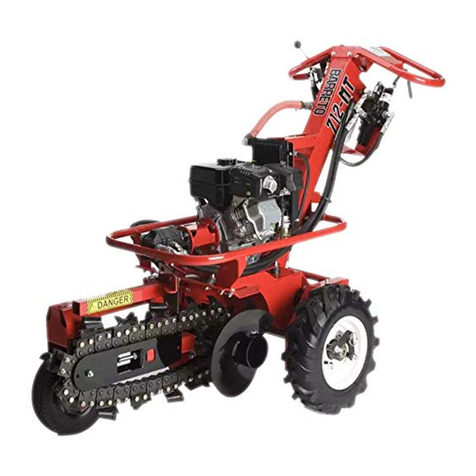
Barreto
Barreto 712MTH User manual

Barreto
Barreto E30SG User manual
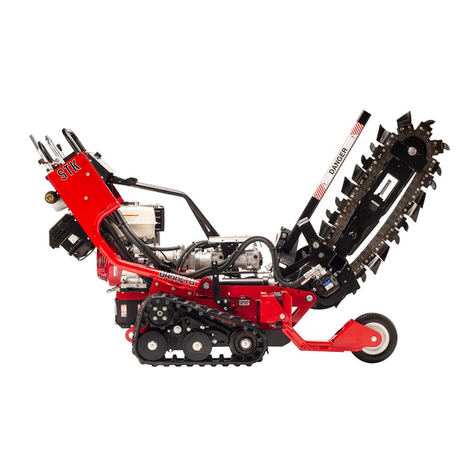
Barreto
Barreto 13STKH User manual

Barreto
Barreto HT712 User manual
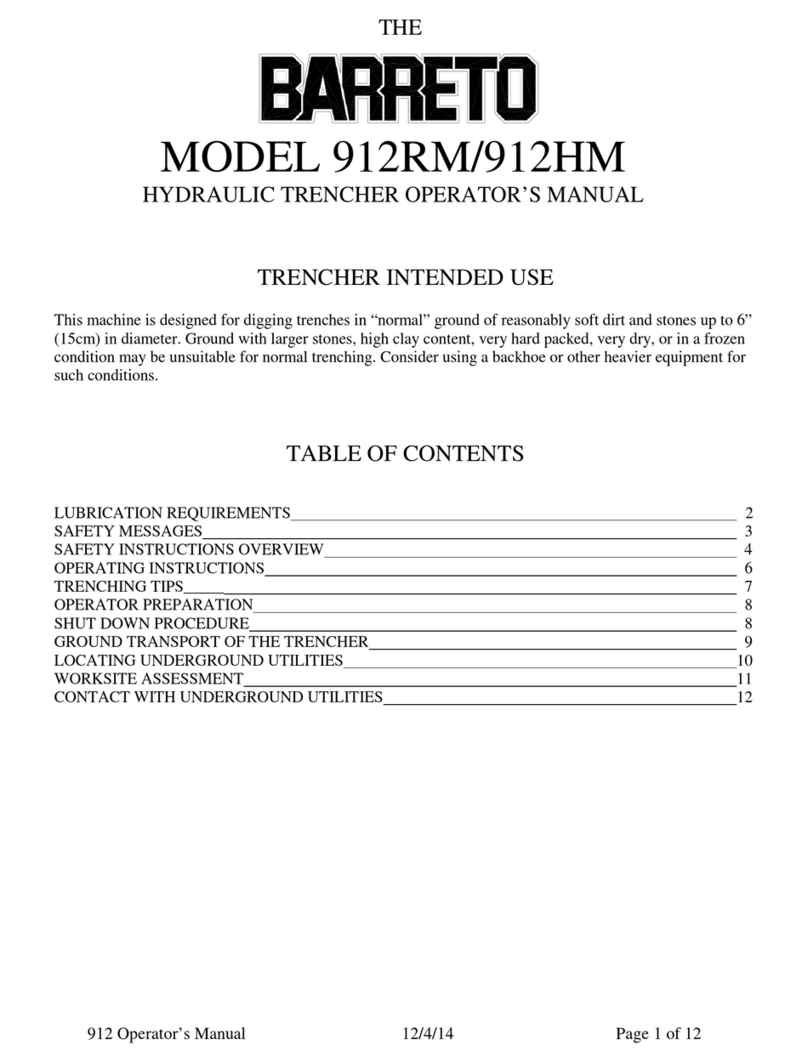
Barreto
Barreto 912RM User manual

Barreto
Barreto 912HM User manual
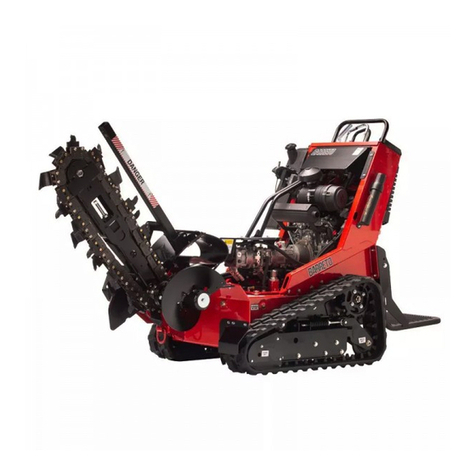
Barreto
Barreto 20RTK User manual

Barreto
Barreto 1324D User manual
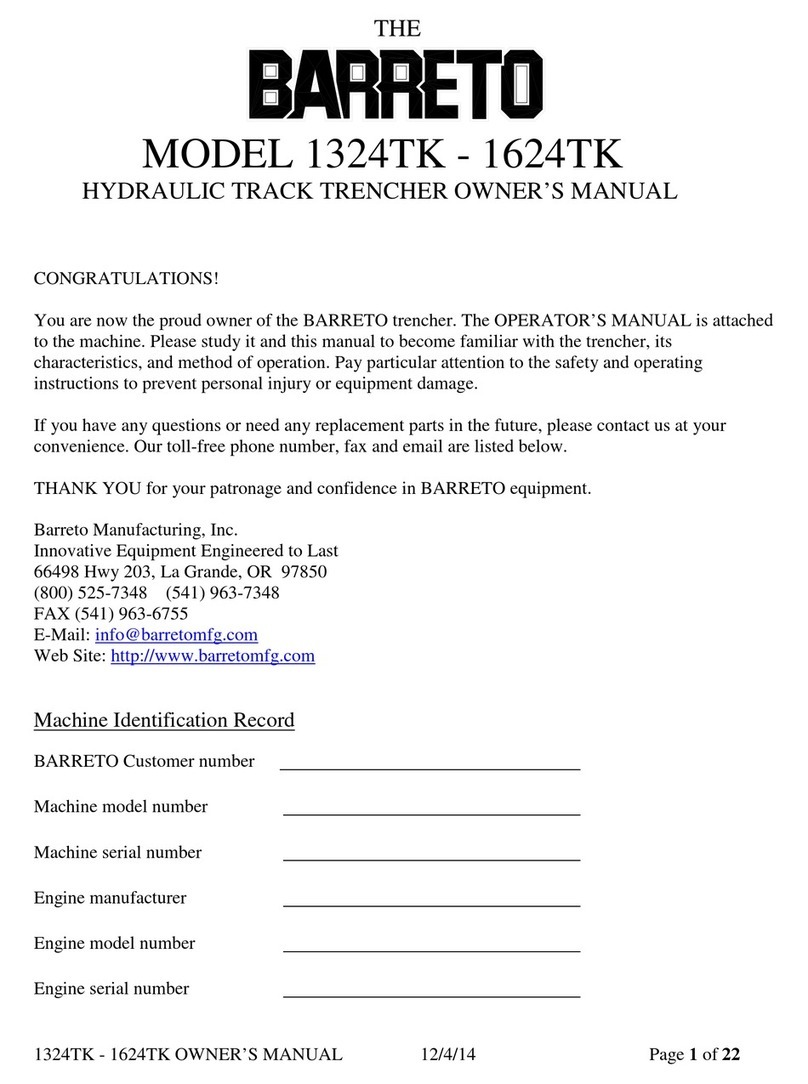
Barreto
Barreto 1324TK User manual
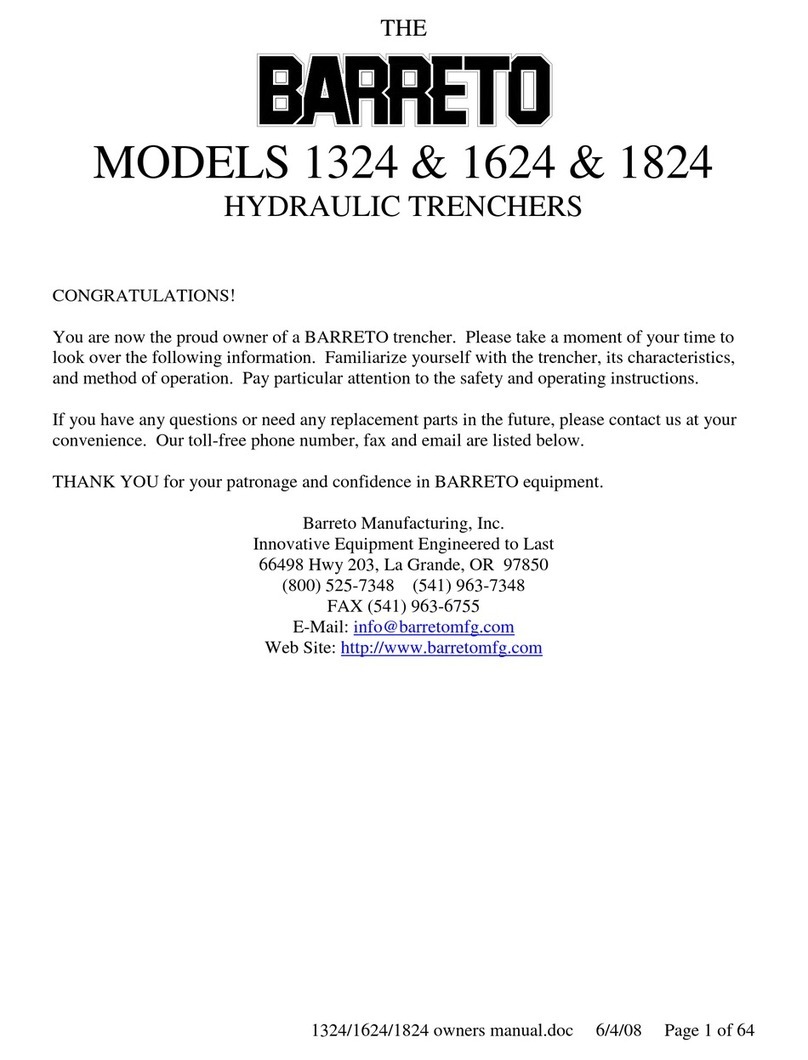
Barreto
Barreto 1324 User manual
